(Biology) ICSE Class X Important Questions : Biology (2007)
Disclaimer: This website is NOT associated with CBSE, for official website of CBSE visit - www.cbse.gov.in
Paper : ICSE Class X Important Questions : Biology (2007)
General Instructions:
- Attempt all questions from Section I and any four questions from Section II.
- The intended marks for questions or parts of questions are given in brackets [ ].
SECTION I (40 Marks)
Attempt all questions from this Section
Question 1
(a) Name the following:- [5]
- Cytoplasmic organelles that help in the manufacture of starch.
- The statistical study of human population
- Pair of genes responsible for a particular characteristic in an individual.
- A solution whose concentration is greater than that of the cell sap.
- The fluid that provides protection and nourishment to the cells of the brain.
(b) State whether the following statements are true or false. If false, write the correct statement by changing the incorrect word/words only. [5]
- Mortality is the number of deaths per thousand of the population per decade.
- The symbiotic bacteria that helps in Nitrogen fixation is Rhizobium radicicola.
- Rods are responsible for vision in the dark.
- The dark reaction of Photosynthesis is light independent.
- Process of fusion of the sperm nucleus and the egg nucleus is termed implantation.
(c) Match the items in column A with those which are most appropriate in column B. You must rewrite the matching pairs. [5]
| Column A | Column B |
| 1. Basic unit of life | A. Glucagon |
| 2. Beta cells of Pancreas | B. Meninges |
| 3. Meiosis | C. Iris |
| 4. Protective covering of the brain | D. Cell |
| 5. Constriction of the pupil of the eye | E. Insulin |
| F. Skin cell | |
| G. Protoplasm | |
| H. Sperm | |
| I. Ciliary muscles. [5] |
(d) Given below is an apparatus used to study a particular process in plants. Study the same and answer the questions that follow:- [5]
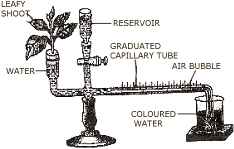
- Name the apparatus.
- Mention one limitation of this apparatus.
- Which phenomenon is studied with the help of this apparatus?
- What is the function of the part marked 'reservoir'?
- What is the role of the air bubble in the experiment?
(e) In the box given below is a list of biological terms that can be used to complete statements that follow. Select the appropriate term from the box and re-write the completed statement. You may use a term only once. Concave, Neuron, Lactic acid, Glucose, Animal waste, Gestation, Nerve, Ethyl alcohol, Nephron, Myopia, DDT, Pregnancy, Convex [5]
- The type of lens used to correct myopia is _______.
- The basic unit of the human brain is the _______.
- The end product of fermentation is _______.
- A non-degradable pollutant is _______.
- The period of complete development of the foetus till birth is termed _______.
(f) Given below are the functions of certain organs/structures found in living organisms. In each case, name the organ or structure that:- [5]
- Produces testosterone.
- Is responsible for protecting the eye from sweat.
- Transmits characteristics from parent to offspring.
- Transports water from the soil to other parts of the plant
- Initiates cell division.
(g) Explain the following terms:- [5]
- Tropic hormone
- Guttation
- Osmosis
- Stereoscopic vision
- Mutation.
(h) Given below is a set of terms arranged in logical
sequence, representing a process or a function. Of these, one term is incorrect.
Identify the incorrect term and replace it with the correct term. One has been
done for you as an example.
Eg. Pollen grain → Exine → Staminal tube → Male gametes
→ Micropyle
Incorrect term - Staminal tube . Correct term - Pollen Tube [5]
- Seminiferous tubule → Sperm → Sperm duct → Accessory glands → Semen → Ureter.
- Soil water → Root hair → Cells of cortex → Epidermis → Xylem.
- Oxygen → Stoma → Respiratory cavity → Mesophyll cells → Oxidation of glucose → 2 A T P.
- Pupil → Eye lens → Vitreous humour → Fovea → Auditory nerve.
- Sensory nerve → Dorsal root ganglion → Sensory Neuron → Motor neuron → Receptor.
SECTION II (40 Marks)
Attempt any four questions from this Section
Question 2
(a) Differentiate between the following on the basis of what is given in
brackets:- [5]
- Bio-fertilizer and Chemical fertilizer (an example of each)
- Karyokinesis and Cytokinesis (Explain the terms)
- WHO and Red Cross (Any one function of each)
- Mitosis and Meiosis (Number of daughter cells formed)
- Pure and Hybrid strains (Definition).
(b) Given below is the diagram of the human ear. Study the same and answer the questions that follow:- [5]
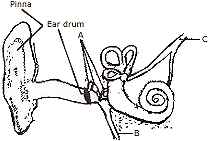
- Give the biological term for the part labelled 'A' and state its function.
- Name the part labelled 'B' and state its function.
- Name the part labelled 'C' and state its function.
- Give the function of ear wax.
Question 3
(a) Answer the following questions briefly:- [5]
- Why is carbon dioxide considered an air pollutant?
- Name any two vaccines and mention the diseases against which they give immunity.
- Mention two reasons for the high birth rate in India.
- State two effects of the smog observed in major cities.
(b) Given below is an experiment, set up by a candidate, to study the process of respiration in plants. The candidate failed to get the expected results, as two mistakes were made while setting up the experiment:- [5]
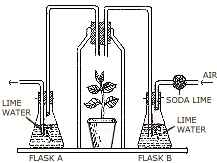
- Identify and state the two mistakes made by the candidate.
- What is the role of soda lime in the experiment?
- What is the purpose of using lime water in flasks 'A' and 'B'?
- Give the chemical equation to represent the process of respiration.
Question 4
(a) [5]
- Draw a neat and well-labelled diagram of the Chloroplast
- List the events taking place in the photo-chemical phase of Photosynthesis.
- If you are planning an experiment to show the effect of light on
photosynthesis:
(l) Will you select white light or green light? Justify your answer.
(2) Why would you select a destarched plant?
(b) [5]
- Explain the term Reflex action.
- Expand the following biological abbreviations:-
(1) DNA
(2) AIDS. - State whether the following actions are 'voluntary action, simple reflex
or conditioned reflex':-
(1) Blinking
(2) Cleaning the table
(3) Playing on the keyboard
(4) Salivating when food is put in the mouth.
Question 5
(a) Given below is a diagrammatic representation of a defect of the human eye:- [5]

- Identify the defect.
- Mention two reasons for the above defect.
- State how the defect can be rectified.
- Name the part of the eye responsible for maintaining the shape of the eyeball.
(b) Name the hormones which lead to the following conditions:- [5]
- Diabetes Mellitus
- Growth of beard in women
- Myxedema
- Gigantism
- Exophthalmic goitre.
Question 6
(a) Study the diagram given below and then answer the questions that follow:- [5]
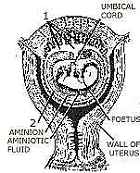
- Name the parts labelled l and 2. State the function of each part.
- State any one function of the amniotic fluid.
- What is the role of the umbilical cord in the development of the foetus?
- Name the part in the diagram which is endocrine in nature.
(b) [5]
- State Mendel's law of Independent Assortment.
- A homozygous Tall plant (T) bearing red coloured (R) flowers is crossed
with a homozygous Dwarf plant (t) bearing white
flowers (r):-
(l) Give the Genotype and Phenotype of the Fl generation.
(2) Give the possible combinations of the gametes that can be obtained from the Fl hybrid. - Give the dihybrid ratio and the phenotype of the offsprings of the F2
generation when two plants of the Fl generation
above are crossed.
Question 7
(a) The diagram given below represents a stage during mitotic cell division in an animal cell:- [5]
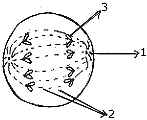
- Identify the stage. Give a reason to support your answer.
- Name the parts labelled l, 2 and 3.
- What is the chromosome number of the cell?
- Draw a neat, labelled diagram of the cell as it would appear in the next stage. Name the stage.
(b) Give reasons for the following:- [5]
- Plants begin to die when excess of soluble fertilizers are added to the soil.
- Injury to the medulla oblongata results in death.
- Gametes have a haploid number of chromosomes.
- Green leaves are thin and broad.
- Lysosomes are termed Suicidal bags of a cell.